ACADEMIC | 2023年天津大学开放式建筑设计大师班Studio成果汇报来啦!(中)

● 前期调研
Previous Research
大邱纺织业经历了很长的历史,随着现代纺织业的诞生,大邱实现了高速发展的状态。
Daegu textile industry has experienced a long history, and with the birth of modern textile industry, Daegu started to develop at a high speed.

但纺织业的高速发展,却带来了很多问题,特别是在生态环境方面:过去许多纺织印染企业的环保意识不强,且生产废水处理不到位,很多剩余污泥也没有得到妥善的处理便直接倾倒,给环境造成了巨大的生态风险。
However, the rapid development of the textile industry brought about many problems, especially in the ecological environment: in the past, many textile companies had little awareness of environmental protection, and industrial wastewater was not treated properly, and sludge was dumped directly without proper treatment, causing a great ecological risk to the environment.

因此,为了降低工业污染对生活的影响,直到20世纪末期,大邱纺织业逐渐走向衰落,纺织产业中心迁移,只有少量纺织工业留在大邱城市。随着大邱产业的发展变迁,其物理城市空间也不断扩张。而留在中心城区的纺织、印染等工业大批外迁,随之产生了郊区化、社会空间不平等等问题,各区人口不断流失。
Therefore, in order to reduce the impact of industrial pollution on life, the center of Daegu's textile industry gradually moved until the end of the 20th century, and only a small amount of textile industry remained in Daegu city. As Daegu's industries changed, its physical urban space expanded. The textile industry that remained in the city left in large numbers, resulting in various problems such as suburbanization and social space inequality, and the loss of population in each district.

总结来看,在过去,纺织业在大邱市的发展中起着至关重要的作用。而纺织产业带来的污染问题和迁移,导致产业与城市分离,逐渐淡出人们的日常生活。那么,如何重拾工业记忆、融入日常生活,是未来城市发展需要重点考虑的问题。
To sum up, the textile industry played a vital role in the development of Daegu in the past. However, the pollution problems and migration brought about by the textile industry have led to the separation of the industry from the city and the gradual fading of the industry from people's daily lives. Then, how to regain the memory of industry and integrate it into daily life is a key consideration for the future development of the city.

目前,这种产业与城市分离的状态,产生了很多负面的影响:由于纺织工业没有产业升级,设施老化,难以保持或提高生产力,活力衰退,新建产业园持续低迷。这些建筑群不仅功能低下,而且不断破坏城市景观的美丽。
Currently, this state of separation of industry from the city has many negative effects: as the textile industry has no industrial upgrading, facilities are aging, it is difficult to maintain or improve productivity, vitality is declining, and new industrial parks continue to be depressed. These complexes are not only low-functioning, but they continue to destroy the beauty of the urban landscape.

产生负面影响的几个主要因素是:工厂占地面积大、功能单一,无法与现代生活相匹配;工业污染及其处理影响日常生活;原有的文脉随工厂迁移而断层,逐渐远离日常生活。
Here we summarize several major factors that produce negative effects: the factories occupy a large area and have a single function that cannot match modern life; industrial pollution and its treatment affects daily life; and the original cultural lineage breaks down with the relocation of factories and gradually moves away from daily life.

所以,我们希望从大邱原始的工业文脉出发,在原来厂址的基础上以原先的工业语言和空间秩序搭建起新的语言和空间秩序,让工厂与生活相融合。
Therefore, we hope to build a new language and spatial order based on the original factory site from the original industrial culture of Daegu, so that the factory can be integrated with life.
● 选址与基地分析
Base Analysis
随着城市的扩张,工业逐渐迁移出中心城区,沿河流分布,形成一条工业带。大邱的历史文脉主要存在于中区和外围部分,而在中区存在着文化断层现象。近现代工业历史文脉集中于老城区周边,而城郊现代工业园区历史文脉稀少。
With the expansion of the city, industries gradually moved out of the central city and were distributed along the river, forming an industrial belt. However, Daegu's historical industrial heritage is mainly concentrated around the old city, while it is almost absent in modern industrial parks.


目前,大邱市已经开始对沿河工业带进行产业再生和升级计划。
Currently, Daegu City has started an industrial regeneration and upgrading plan for the industrial zone along the river.

我们基于《2025年大邱广域市城市再生战略计划》,选取三处城市经济基础型之一的老工业园区作为选址,进行产业与城市结合新模式的尝试。
We selected one of the three old industrial parks as our site based on the "Daegu Metropolitan City Urban Regeneration Strategic Plan 2025".

场地存在这三种问题:使用密度过低、缺乏生长性、使用功能单一。我们希望从生产和生活两大功能体系入手,通过工业生产、历史展示、休闲娱乐三区的功能结合,为原有的纺织工业找到新的发展方向,以期找到平衡生产、生活的产业模式范式。
The site has these three problems: low use density, lack of growth, and single use function.We hope to find a new direction for the original textile industry by combining the functions of three zones: industrial production, historical exhibition, and entertainment, with a view to finding a paradigm for an industrial model that balances production and life.

● 设计成果
Design Achievement
我们希望用设计讨论一个工厂的多种可能——工厂森林。
We want to use design to discuss the many possibilities of a factory - a Factory Forest.
原有的厂房存在平铺浪费、生产效率低下等问题。
As mentioned before, the original factory building has problems such as flat waste and low production efficiency.

我们希望打散不同功能属性的空间,把他们混合重组,弥补各个功能空间之间的缺点,提升空间利用效率,并形成一个可生长的循环系统。
We hope to break up the spaces with different functional attributes and then mix them to make up for the shortcomings of each functional space, improve the efficiency of space utilization, and become a growable circulation system. However, while the functions were diverse, the closely arranged links in the production line were also separated.

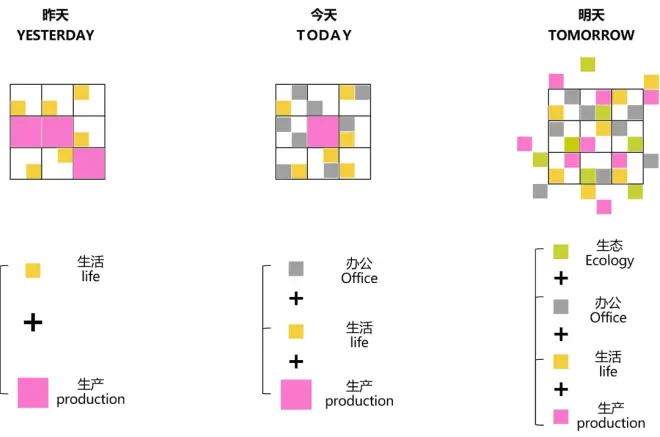
但功能丰富的同时,生产线里紧密排列的环节也被分开了。我们研究了一下整个工艺流程。我们发现纺织流程的每个环节所需要的空间大致是一样的面积,污水处理也是一样,即每个生产环节可以被简化为一个固定尺寸的最小单元。
However, while the functions are enriched, the closely arranged links in the production line are separated. We studied the entire process flow. We found that the space required for each link of the textile process is roughly the same area, and so is the wastewater treatment, i.e. each production link can be reduced to a minimum unit of fixed size.

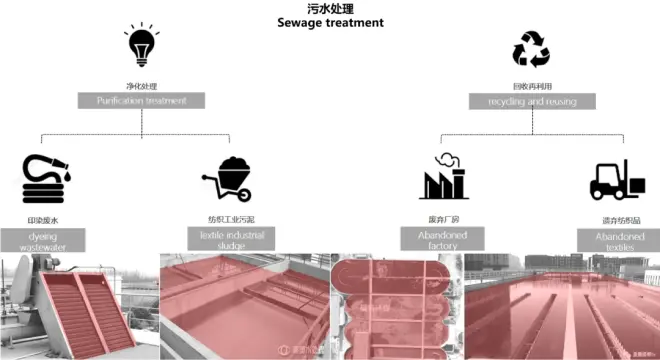
因此,我们希望通过产业上楼的形式,将整个生产流程中的环节以最小单元为单位纵向排列,使单位面积上的生产效率提高,也为功能空间的渗透组合创造了可能性。
Therefore, we hope to arrange the links in the whole production process vertically as the smallest unit through the form of industrial upstairs, so that the production efficiency per unit area can be increased, and also create the possibility for the permeable combination of functional space.

以下是我们的建筑生成思路:我们将工厂形态由平铺改为垂直,在垂直的生产单元周围附着公共空间,多个垂直生产单元排列形成“工厂森林”。
Here is our idea of building generation: we change the factory form from flat to vertical, and attach public space around the vertical production units, and arrange multiple vertical production units to form a "factory forest".

我们将这个概念视为一种对未来城市边缘工业园区的改造设想,“生产线的森林” 是城市产业升级过程中遗留的旧厂房在城市中的一种新形态,也是对旧有工业文脉的呼应。
We see this concept as a vision for the transformation of the future industrial park at the edge of the city. The "forest of production lines" is a new form of the old factory buildings left behind in the process of urban industrial upgrading, and echoes the old industrial culture.

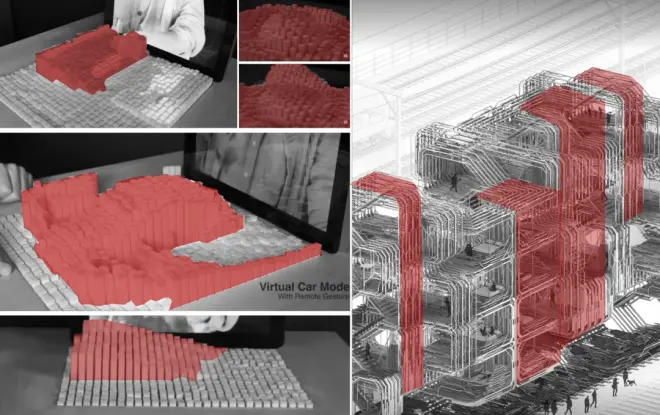
它的每个垂直单元都与旧厂房的结构框架相当,尺寸为10*10*9,该尺寸也是前文提到的最小工业单元的尺寸,相当于我们按场地上的原厂房结构尺度上建立这一新的垂直框架。
Each vertical unit of it is comparable to the structural frame of the old factory building, with the size of 10*10*9, which is also the size of the smallest industrial unit mentioned before, and we are building this new vertical frame on the scale of the original factory structure on the site.

下一步,我们希望将污水处理、生活绿化等功能置入空间,为这片新型工厂置入社会文化属性。我们进一步明确了前文提出的“渗透型”工业街区模式。这种空间模式具有可变性,这个未来的工业社区能够以动态平衡的方式维持一个理想的生产-生活-生态功能比例,根据不同的地形、使用需求等等因素,多种功能在场地上的不同区域聚集或分散,任何功能、任何高度的垂直单元都可以在统一的框架内被搭建。
We also wanted to place the functions of sewage treatment and greenery into the space, and put social and cultural attributes into this new factory.We further clarify the " penetrating" industrial neighborhood model proposed in the above section. This spatial pattern is variable, and this future industrial community can maintain an ideal production-life-ecology function ratio in a dynamic and balanced way, depending on the topography, usage needs and other factors, multiple functions can be gathered or dispersed in different areas of the site, and vertical units of any function and height can be built within a unified framework.

另一方面,这种空间形式具有生长可塑性。它与旧厂房共享同一个单元尺寸的框架,可以直接嵌入旧厂房并生长蔓延,逐渐代替原有的平铺式的工业模式,最终完成更新迭代。
On the other hand, this spatial form has growth plasticity. It shares the same unit size frame with the old factory building, and can be directly embedded in the old factory building and grow and spread, gradually replacing the original flat industrial model and eventually completing the renewal iteration.

我们设定了生产、生活、生态以及交通四种功能模块,并针对不同的地形和场所以及环境因素等三大类影响因素,制定了各个模块彼此之间的连接规则,最终生成多种功能混合的算法结果,最后通过建立筛选机制,生成最适合于场地的模型。
We set up four functional modules: production, living, ecology and transportation, and developed rules to connect each module with each other for three types of influencing factors such as different topography, daylight conditions, and population distribution, etc. Finally, we generated the algorithm results of multiple functional mixes, and finally generated the most suitable model for the site by establishing a filtering mechanism.

以下是GH内的电池组展示,我们可以根据设定的规则在不同种类的场地里生成随机模型。
The following is a demonstration of the battery within GH, where we can generate random models in different kinds of sites according to the set rules.
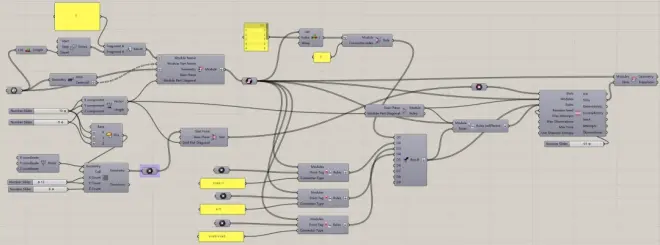
这种生长可塑性的工业模式,可以随着工厂的发展逐渐覆盖沿河的工业带,让生产和生活、生态相融合。
This kind of growth plasticity industrial model can gradually cover the industrial zone along the river with the development of the factory.


我们以下面这个地块为例进行基地分析。场地内要素较多,西侧有污水处理,北侧有河流和绿地空间,且有一条道路连通至河对岸。我们根据地形和周边功能进行大致的功能分区。每个功能区域都以一种功能单元为主导,其余功能单元渗透其中并且逐渐扩散,最终填满场地。
There are many elements in the site, with sewage treatment on the west side, a river and green space on the north side, and a road connecting to the other side of the river. We made a general functional zoning based on the topography and surrounding functions. Each functional area is dominated by one type of functional unit, and the rest of the functional units penetrate and gradually spread out, eventually filling the site.
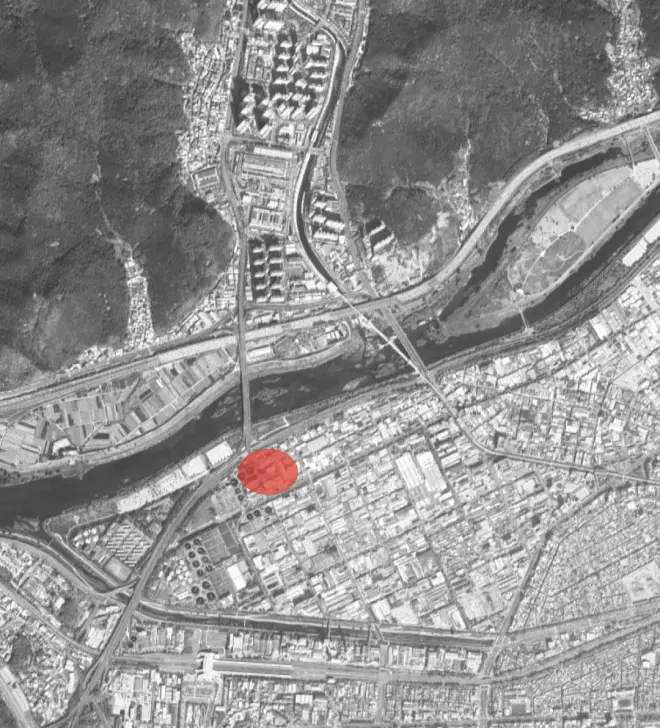

我们仍然以10*10* 9为基本的垂直单元尺寸,九个垂直单元块为一组,成形成了五种不同的功能空间和组合模式。为了应对不同工业园区的场地情况,我们设想了这五种单元针对五种不同地形的组装模式,它们能够在场地上排列组合出高低起伏的“工厂森林”。
We still use 10*10*9 as the basic vertical unit size, and every nine vertical units are grouped together to form five different functional spaces and combination patterns.In order to cope with different site conditions, we envisioned these five units assembled in five different terrain patterns, which can be arranged on the site to create a "factory forest" of different heights.

下面我将分别介绍生产、生活、生态单元在这个框架内的运行模式。
I will introduce the production, living and ecological units within this framework.


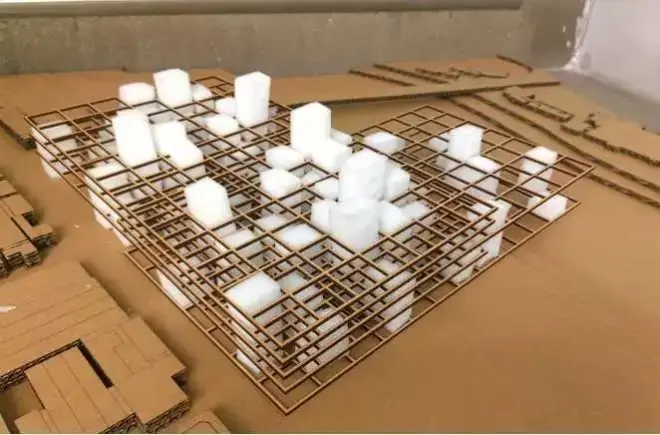
生产单元
Production Unit


我们将明确建筑内的生产循环流程,即纺织原料进入这片工厂森林后将如何经历每一个加工环节,垂直单元内部将会有怎样的交通运输。
We will define the production cycle in the building, i.e. how the textile material will go through each processing stage after entering this factory forest, and how the transportation will be inside the vertical unit.

我们通过文献研究确定了生产各个环节的面积大小,将生产流程和周边附属功能空间,进行竖向的重新组织,形成新的生产流程环节,让原有的工业流线从二维转向三维。
After determining the area size of each production link, we organize the production process and the surrounding subsidiary functional space vertically, so that the original industrial flow line is shifted from two-dimensional to three-dimensional.

这种生产模式也为不同规模的生产活动运作提供了可能:垂直生产单元通过不同的整合或组合,为微小企业、手工作坊以及成熟企业都提供了对应的生产线规模与配套办公空间。
This production model also offers the possibility to operate production activities at different scales: vertical production units are integrated or combined in different ways to provide the corresponding production line scale and supporting office space for micro-enterprises, handicrafts as well as established companies.

这是工业生产的整个交通运输流线。通过附加塔吊设施的顶部桁架从顶层输送生产原料至垂直车间,经过加工后将成品在底层汇总运输。相比之下,人的活动路线在中间层可以灵活穿梭,最终,生产单元通过自由组合与运输流线组织成为垂直工厂的运行基础,附加的生态单元为车间废水提供初步过滤和环境绿化,而附加的生活单元提供了车间工作人员进行办公会议的空间。
This is the entire transportation flow of the industrial production. The top trusses with additional tower crane facilities transport production materials from the top floor to the vertical shop, and after being processed, the finished products are aggregated and transported on the bottom floor.In contrast, the route of human activity is flexible in the middle level. Ultimately, the production units become the basis for the operation of the vertical plant through the free combination and organization of the transport flow, the additional ecological unit provides initial filtration of the factory wastewater and environmental greening, and the additional living unit provides space for office meetings of the factory staff.

生活单元
Living Unit

其次是生活单元的运行模式。对于生活部分,以商业、展示、研发等辅助工业生产的功能为主,协助工业生产形成完善的产业链。
Next is the operation mode of the living unit. For the living part, the functions of commercial, exhibition, R&D and other auxiliary industrial production are mainly used to assist industrial production to form a perfect industrial chain.


空间形式上,生活单元大部分与旧厂房连接紧密,通过挤压、分离、倾斜等操作手段,产生新的建筑语言形式,为生活单元的空间提供了更多的可能。
In terms of spatial form, most of the living units are closely connected with the old factory buildings, and through such operational means as extrusion, separation and inclination, new forms of architectural language are produced, providing more vitality and a sense of industrial culture to the space of the living units.

生态单元
Eco-Unit

对于生态单元,考虑到上面提到的大邱的工业污染,我们把大邱的绿色系统放到生态单元中,选择大邱常见的或对纺织污染净化有好处的植物,让它们对生产单元产生的污水污泥进行净化,并把它们错落有致地放在场地中,使工厂具有小森林的生态模式。
For the eco-unit, considering the industrial pollution in Daegu mentioned above, we put the green system of Daegu into the eco-unit by selecting plants that are common in Daegu or are good for textile pollution purification, so that they can purify the sewage sludge produced by the production unit and place them in the site in a staggered manner, so that the plant will have the ecological pattern of a small forest.


纺织业最初的革命来自于珍妮机,它把原来的水平锭变成了直立锭,在我们最疯狂的梦想中,纺织厂的生产线可以成为一个垂直的森林,创造一个新的工厂模式,并与城市范式相结合,这是我们对未来的一个美好目标。
The original revolution in the textile industry came from the Jenny machine, which turned the original horizontal spindle into an upright one, and in our wildest dreams, the textile factory line could become a vertical forest, creating a new factory model and combining it with the urban paradigm, a wonderful goal in our fantasy future.

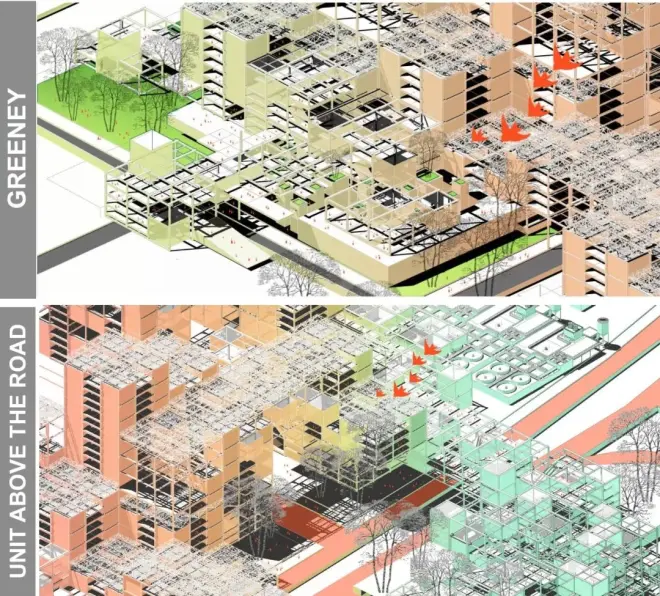
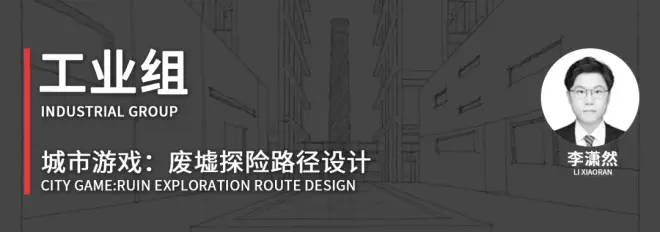
● 前期调研
Previous Research
我正在从历史和文化方面探索产业是如何与人们的生活相结合的。
I am exploring how industry is integrated with people's lives from the historical and cultural aspects.

首先,我对大邱纺织业的历史进行了梳理和研究。大邱的现代纺织业始于日本殖民时期。随着城墙的拆除和传统城市空间的解构,该产业定义了这座城市。20世纪80年代以后,随着城市规模的扩大和新的城市需求,产业与城市分离,纺织工厂相继外迁,纺织业逐渐淡出中心城区和人们的日常生活。
Firstly, I combed and studied the history of Daegu's textile industry. The modern textile industry in Daegu began during the Japanese colonial period. With the demolition of city walls and the deconstruction of traditional urban space, the industry has defined the city. After the 1980s, with the expansion of urban scale and new urban demands, industries and cities were separated, textile factories moved out one after another, and the textile context gradually faded from the central urban area and people's daily life.

在此基础上,我对大邱的工业背景、工厂形态、生产活动、生产设备的演变发展进行了研究和整理。并对这些支离破碎的历史节点和空间碎片进行重组,提取原型。
Then I researched and organized the evolutionary development of Daegu's industrial background, plant forms, production activities and production equipment in relation to this timeline. And these fragmented historical nodes and spatial fragments are reorganized and prototypes are extracted.
● 设计成果
Design Achievement
基于城市层面的分析和上述研究,我提出了一种名为"城市游戏"的设计策略。
Based on the city-level analysis and the above research, I propose a design strategy called City Game.
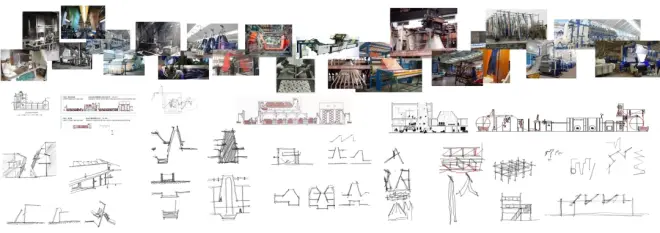
大邱已经失去了它的纺织文化和工厂历史,它的城市文脉已经被消费和现代化所挤压。本设计希望通过城市游戏和建筑叙事唤醒这段沉默的历史。
Daegu has lost its textile culture and factory history, and its urban context has been squeezed out by consumption and modernization. This design hopes to awaken this silent history by means of urban games and architectural narratives.


以城市中残存的印染厂废墟为背景,想象时间、自然和工业如何将这里变成一片废墟丛林,隐藏着纺织记忆和工厂遗迹,并为游客增加一条游戏路线。根据大邱纺织业的历史,设置了"旧城"、"起点"、"工厂"、"庆典"、"机器"、"废墟"、"迷宫"、"新生"等一系列游戏关卡。
Set in the ruins of the printing and dyeing factories that remain in the city, imagine how time, nature and industry have turned this place into a jungle of ruins that hides textile memories and factory remains, and add a game route for visitors. A series of game levels including "Old City", "Beginning", "Factory", "Festival", "Machine", "Ruins", "Labyrinth" and "New Life" are set according to the history of Daegu textile industry.

我把反映印染厂历史和大邱纺织工业变迁历史的叙事路线作为废墟探险的游戏路线,把工厂内剩余的界面和走廊作为游戏路线的引导,把象征工厂历史和生产过程的符号连接起来。
I used a narrative route reflecting the history of the printing and dyeing factory and the history of the changes in the Daegu textile industry as the game route for the ruin adventure, and used the remaining interfaces and corridors in the factory as a guide for the game route, linking the symbols that symbolize the history of the factory and the production process.

接下来是各个游戏关卡的介绍。
Next is the introduction of each game level.

场景1:老城
Eco-Scene 1: Old City

在工业塔的吸引下,玩家进入废墟公园。废墟公园的入口是一片森林。在穿越森林的过程中,玩家会联想到20世纪50年代以前,大邱古城墙内传统的植桑养蚕的手工编织时代。
Attracted by the industrial tower, players enter the ruined park. The entrance to the ruined park is a forest. In the process of walking through the forest, players think of the traditional hand-woven era of mulberry planting and silkworm rearing in the walled old town of Daegu before 1950s.
场景2:开始
Scene 2: Beginning

穿过树木和破旧的建筑,玩家们来到一条穿过屋顶和墙壁的长廊。走廊和建筑的冲突象征着日本殖民时期大邱开始纺织业现代化时拆除墙壁和建造火车站。
Through trees and dilapidated buildings, the players make their way to a long corridor that cuts through roofs and walls. The clash of corridors and structures symbolized the demolition of walls and the construction of railway stations during the Japanese colonial period, when Daegu began to modernize its textile industry.
场景3:工厂
Scene 3: Factory

连接走廊的尽头通向下一个建筑,这是一个圆桶形的高耸纪念碑式建筑,光线通过天窗洒向底部的染缸,布料在空间中流动。
The end of the connecting corridor leads to the next building, a barrel-shaped, towering monumental structure with light streaming through skylights onto the dye vats at the bottom and the fabric transferred through the space.
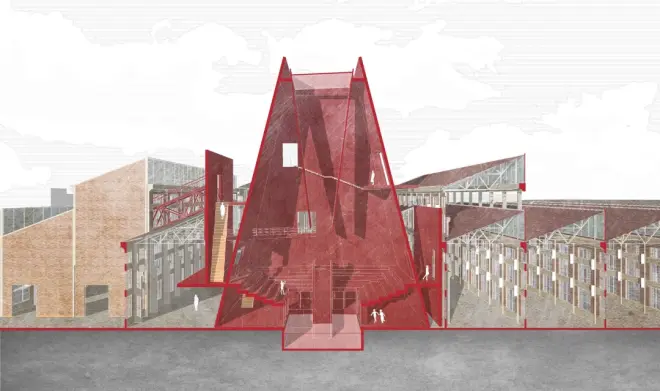
游戏者不禁联想到20世纪60年代该行业定义城市时如火如荼的生产和染色场景。
The gamer can't help but think of the production and dyeing scene in full swing when the industry defined the city in the 1960s.
场景4:节日
Scene 4: Festival

游戏者走出工厂,沿着宿舍外的垂直操场和连接走廊,来到漂浮在屋顶上的网架平台,发现这里有一个露天展览广场。
The gamer walks out of the factory, along the vertical playground and connecting corridor outside the boarding house, to the net frame platform floating on the roof, where he finds an open-air exhibition square.
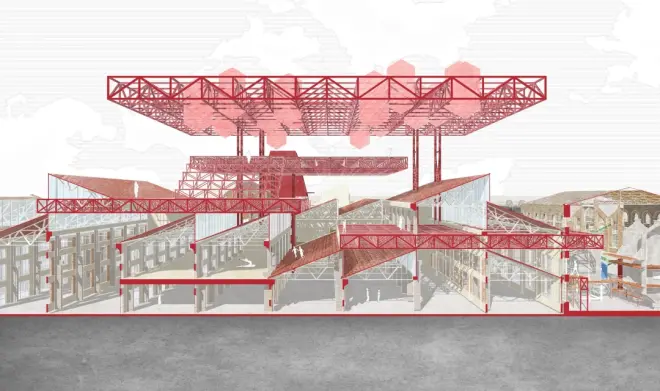
20世纪60年代,大邱的经济在纺织业的带动下飞速发展,人们的生活与纺织业密不可分。
1960s period, Daegu's economy soared under the impetus of the textile industry, and people's lives were inseparable from textiles.
场景5:机器
Scene 5: Machines

沿着连接走廊走下屋顶,游戏者进入了一个封闭的工厂,这个空间里充满了各种工业机器。无意间走进机器,他惊讶地发现,在冰冷的机械外表下,一个柔软舒适的生活空间被囚禁在里面。
Walking down the roof along the connecting corridor, the gamer enters a closed factory, a space filled with various industrial machines. Walking into the machine unintentionally, he is surprised to find a soft and cozy living space imprisoned inside under the cold mechanical exterior.

这台机器象征着20世纪70年代大邱纺织工业的解体,纺织机器被出租给家庭作坊,人们的生活被工业所禁锢。
The machine symbolizes the disintegration of Daegu's textile industry in the 1970s, when textile machines were rented out to family workshops and people's lives were confined by industry.
场景6:废墟
Scene 6: Ruins

游戏者再次沿着空无一人的走廊走到叠加在厂房废墟之上的新建筑。通过新旧建筑的叠加,暗示了20世纪80年代后,工业与城市分离,纺织厂外迁,在原有厂房的基础上新建了居民楼,工业从人们的生活中走了出来。
The gamer again walks up the empty corridor to the new building superimposed on top of the ruins of the factory building. Through the superposition of the old and new buildings, it is implied that after 1980s, the industry and the city separated, the textile factories moved out, new residential buildings were built on the basis of the original factory buildings, and the industry came out of people's lives.
场景7:迷宫
Scene 7: Labyrinth

游戏者来到一座支离破碎的建筑前,残存的水泥柱和断壁残垣组成了一座迷宫,看着远处出现的高塔,废墟中时隐时现的走道丧尸,却找不到出路。从上世纪90年代的迷茫探索阶段开始,大邱已从时尚产业、高科技纤维技术等方面寻求纺织产业转型。
The gamer comes to a fragmented building, the remaining concrete pillars and broken walls form a maze, looking at the tower that appears from afar, and the runway walkers that appear and disappear in the ruins, but he cannot find a way out. From the confusing exploration stage in the 1990s, Daegu has sought to transform the textile industry from the fashion industry, high-tech fiber technology and other aspects.
场景8:新生活
Scene 8: New Life

穿过废墟丛林,游戏者终于走出迷宫,看到象征起源的工业高塔从河边拔地而起,那一刻,游戏者热泪盈眶,仿佛见证了城市的重生。垂直生产模式单元被作为整个序列的高潮,象征着未来工业与生活结合的新方式,工业重新进入城市和人们的生活。
Through the jungle of ruins, the gamer finally comes out of the labyrinth and sees the tall tower of industry rising from the river symbolizing its origin, a moment that brings tears to his eyes, as if witnessing the rebirth of the city. The vertical production mode unit is used as the climax of the sequence, symbolizing the new way of combining industry and life in the future, with industry re-entering the city and people's lives.

● 前期调研
Previous Research
大邱市有着源远流长的纺织历史,最早可以追溯至公元前2千年,延续至今大邱的纺织业成为其最具文化特征和文化内涵的产业之一。
Daegu has a long history of textile, which can be traced back to the 2 millennium BC. The textile industry in Daegu has become one of the industries with the most cultural characteristics and cultural connotation.

并纱在棉纺织工业中对纱线质量和品质有着决定性的作用,并纱作为加捻的前道工序,并纱机的效率和工艺决定了后续倍捻的速度和质量,均匀的纱线张力、较高的卷绕密度和良好的卷绕成形方式和是的高质量卷装的关键。
As the previous process of twisting, parallel yarn and yarn machine efficiency and technology determine the speed and quality of subsequent double twisting, uniform yarn tension, high winding density and good winding forming mode and is the key to high quality winding.

弹簧张力夹通过改变摩擦盘的贴合压紧程度,实现增大或者减小夹片的摩擦力。如需要增大张力时,通过弹簧对摩擦盘施加更大的压力,进而增大张力值。门式张力夹主要通过垫片或者调整闭合程度保证纱线张力稳定,但是当并线机速变化较大时,纱线并合张力波动较大,引起纱线毛羽量以及断头率增加。
The spring tension clamp increases or decreases the friction force of the clamp by changing the degree of fitting and pressing of the friction disc. If you need to increase the tension, through the spring to apply more pressure on the friction disc, and then increase the tension value.

考虑到整个系统的转轴、它们相互之间的传动方式、对位关系,将之转化为建筑构图。
Considering the rotating shaft of the whole system, the transmission mode between them and the counterpoint relationship, it is converted into a section from the longitudinal.

韩国洗浴文化历史悠久,可以追溯到公元前37年的新罗王朝。在韩国古代,公共浴池是人们重要的社交场所,在那里,人们不仅可以洗澡,还可以洽谈业务、疏导情绪、缓解压力。此外,它也是一个重要的医疗场所,人们在这里可以接受药浴和按摩等治疗。
Korean bathing culture has a long history dating back to the Silla Dynasty in 37 BC. In ancient Korea, public baths were important social places where people could not only bathe, but also negotiate business, channel emotions and relieve stress. In addition, it was an important place for medical treatment, where people could receive medical baths and massages.

韩国是一个拥有悠久佛教历史的国家,佛教在这里已经有1500多年的历史; 世界各地的信徒在韩国寺院进行行住坐卧、修行和禅修等活动。
South Korea is a country with a long history of Buddhism, which has been practiced here for more than 1,500 years. Followers from all over the world perform activities such as walking, sitting, lying down, practicing and meditating in Korean temples.

我们从纺织工人的生存状况入手,了解到他们日常工作生活的繁重和单调、娱乐途径的匮乏、心灵的疲惫。由于韩国洗浴文化盛行,泡澡的同时和同事们聊天下棋是纺织工人们最大的消遣方式。但是,他们洗浴和桑拿的场所却卫生条件差、阴暗、简陋。
Starting from the living conditions of textile workers, we can understand their heavy and monotonous daily work, lack of entertainment, mental exhaustion and monotonous daily life scenes. Because of South Korea's bathing culture, chatting with colleagues while taking a bath is a popular pastime for textile workers. But the places where they take baths and saunas are kind of unsanitary, dark and crude.

本设计意在关注纺织工业区工人的生理和心理需求,创设一个体验感丰富的洗浴空间,令纺织工人在疲惫、单调、重复的工作之余可以获得休闲。
This design aims to pay attention to the physiological and psychological needs of textile workers and create a bathing space with rich experience, so that textile workers can get leisure after tired, monotonous and repetitive work.

在此之外,更进一步,试图为纺织工人提供一个心灵放空的冥想空间,以达到一种内心的平和与安定。并结合工厂的工业景观,创设一种机械于外,混凝土于内的禅宗美学。
Further, trying to provide textile workers with a mind free meditation space. To achieve a kind of inner peace and stability.Combined with the industrial landscape of the factory, it creates a Zen aesthetic with machinery outside and concrete inside.
● 设计成果
Design Achievement
建筑坐落于工业区内部,印染池旁的空间。主体分两部分构成:分别是织物层和结构部分。人在浴场之中沐浴由织物形成遮蔽关系,与纺织历史文脉呼应。
The building is located in the interior of the industrial area, the space next to the printing pool. The main body is composed of two parts: fabric layer and structure. People bathing in the bath formed a shielding relationship by the fabric, which echoes the historical context of textile.

而这层关系与人的身体和织物之间的关系类似,暗喻人在建筑之中脱掉日常生活中代表身份和品味的纺织物以后,在混凝土的浴场之中,心无挂碍地将思想放空。
This relationship is similar to the relationship between the human body and the fabric, implying that after people remove the clothes that represents identity and taste in daily life in the building, they can empty their minds without any obstacles in the concrete bath.

基于这一理念生成了模型。在模型内部空间的变化和冥想氛围的营造成为了重点。
Based on this concept, a model has been generated. The focus is on the changes in the interior space and the creation of a meditative atmosphere.

一层经过一系列的入口序列(入口广场、步道)可达服务台。
The first floor can reach the service desk through a series of entrance sequences (entrance plaza, walking path).



首层主要包含:冥想沐浴、旋转浴场、观景沐浴三类空间;二层空间主要是疗愈浴场;三层为私人浴场和观景台。
The first floor mainly contains three types of Spaces: meditation bath, rotating bath and viewing bath. The second floor is mainly a healing bath. The third floor has a private bath and observation deck.


沐浴
Bathing
韩国的沐浴文化源远流长。无论是传统的公共浴场还是现代的高端温泉酒店都有不同的入浴体验。下面介绍几种韩国浴:
South Korea has a long history of bathing culture. Both traditional public baths and modern high-end hot spring hotels have different bathing experiences. The following is the introduction of several kinds of Korean bath:

韩国蒸汽浴:值得一提的是,在传统的韩式汗蒸房里,人们可以享受深层清洁和排毒的乐趣。韩式蒸汽浴是将锅炉加热后的水倒入房间地板下的通道中的沙石中,在蒸汽的作用下,沙石中的水分被蒸发掉,从而达到排毒的目的。
Korean steam bath: It is worth mentioning that people can enjoy deep cleansing and detoxification in traditional Korean sweat steam rooms. In a Korean steam bath, heated water from a boiler is poured into the sand and rocks in a tunnel under the floor of a room.
按摩浴:按摩浴在韩国非常流行。由于快节奏的生活方式,很多顾客在疲劳之后会选择来按摩浴池进行全身按摩和治疗,以缓解压力和渗透压垢。
Massage baths: Massage baths are very popular in Korea. Due to the fast-paced lifestyle, many customers choose to come to the massage bath after experiencing fatigue to get a full body massage and treatment to relieve stress and permeate the pressure scale.
药浴:韩式药浴通常使用肉桂、干姜和草药等芳香物质的混合物。这些草药具有促进身体血液循环、缓解疲劳和滋润皮肤的功效。在草药浴中,人们可以感受到体温的升高,从而促进人体新陈代谢,舒缓身体。
Herbal baths: Korean herbal baths are usually infused with a mixture of aromatic substances such as cinnamon, dried ginger and herbs. Because of their properties, these herbs can stimulate blood circulation in the body, relieve fatigue and moisturize the skin. In herbal baths, people can feel the increase in body temperature, thus boosting human metabolism and soothing the body.
盐浴:韩式盐浴的最大优点是可以滋润皮肤。在盐浴中,可以感受到棕色糖块的颜色,以及浓浓的天然盐味,盐味可以深入皮肤内层,加快新陈代谢,从而舒缓红肿和湿疹。
Salt bath: The greatest advantage of Korean salt bath is that it can nourish the skin. In a salt bath, one can feel the color of brown candy bars, as well as the strong natural salt taste, which penetrates deep into the inner layer of the skin and speeds up metabolism, thus soothing redness and eczema.
冥想
Meditation
冥想通常是指在静默中专注于自我意识,以放松身心。冥想空间是提供安静、舒适空间的场所,使人们更容易冥想和放松。以下是几种不同类型的冥想空间:
Meditation usually involves focusing on one's self-awareness in silence to relax one's body and mind. Meditation Spaces are places that provide quiet, comfortable Spaces that make it easier for people to meditate and relax. Here are a few different types of meditation Spaces:

起居室:静坐室通常是一个无噪音、明亮、平静的房间,让人们在安静舒适的环境中冥想。这些房间通常配有几个坐垫或椅子,人们可以以任何适合自己的方式自由坐或躺。
Sitting Room: A sitting room is usually a noise-free, bright, calm room that allows people to meditate in a quiet and comfortable environment. These rooms are usually fitted with several cushions or chairs, and people are free to sit or lie down in any way that suits them.
自然场所:户外自然场所,如季节性花园、树林或田野,可以为冥想提供良好的环境。这些地方通常有舒适的座椅,人们可以静静地坐着,同时观察周围的自然景观,在自然环境中感受宁静和放松。
Natural places: Outdoor natural places, such as seasonal gardens, woods or fields, can provide a good environment for meditation. These places usually have comfortable seating for people to sit quietly while observing the surrounding natural landscape and feeling peaceful and relaxed in the natural environment.
音乐冥想:它通常将冥想和音乐结合起来,通过音乐帮助人们放松、平静思想、控制情绪、减轻压力和焦虑。通常,在听音乐时,人们会专注于音乐本身,与束缚思想的杂念分开,这可以帮助人们进入冥想状态。在音乐冥想中,音乐通常被用来帮助人们放松身体。音乐的节奏、节拍和旋律可以影响心率和呼吸,激活身体中的愉快神经,使身体感觉更加放松。
Musical meditation: It usually combines meditation and music to help people relax, calm thoughts, control emotions, reduce stress and anxiety through music. Often, when listening to music, people focus on the music itself and separate from the distractions that bind the mind, which can help people get into a meditative state.In musical meditation, music is often used to help people relax their bodies. The rhythm, beat, and melody of music can affect heart rate and breathing, and activate pleasant nerves in the body, making the body feel more relaxed.
观景台
Meditation overlooks
面对大邱市最悠久的工业传统河流,设置了一系列空间序列和冥想眺望台。水面为人们创造了一种平静的氛围,流水声作为白噪声屏蔽了周围的噪音。
A series of spatial sequences and meditation overlooks have been set up facing the river with the longest industrial tradition in Daegu city.The building faces the river and retreats. The water surface creates a calming atmosphere for people and the sound of flowing water acts as white noise to shield the surrounding noise.


同时,内部设置大量水域,作为公共浴场,使得场地内部的水面与远处河流浑然一体。At the same time, a large amount of water is introduced into the interior, so that the water inside the site is integrated with the distant river.
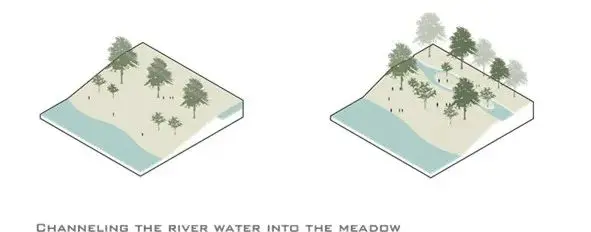

场地原有的纺织印染污水池和污水灌得以存储下来作为工业符号的象征。
The original textile dyeing and printing wastewater pool and sewage storage became a symbol of the industry's dependence on the site.
● 导师评语
Comments from the Lecturers







